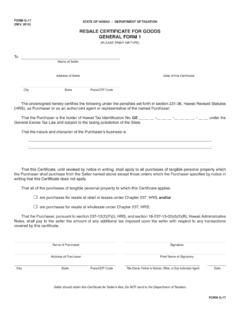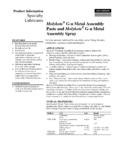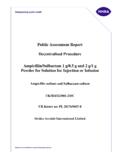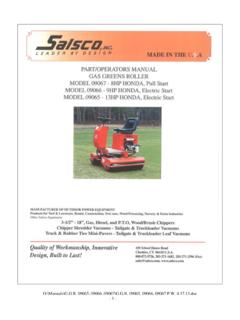Transcription of 13.2 Consider the reaction: 2 N2O (g) → 2 N2 (g) + …
1 Consider the reaction: 2 n2o (g) 2 N2 (g) + O2 (g) A. Express the rate of the reaction with respect to each of the reactants and products. B. In the first s of the reaction, mol of O2 is produced in a reaction vessel with a volume of L. What is the average rate of the reaction over this time interval? C. Predict the rate of change in the concentration of N2O over this time interval. In other words what is ? SOLUTION: A. B. C. This reaction is first order in N2O5: N2O5 (g) NO3 (g) + NO2 (g) The rate constant for the reaction at a certain temperature is /s. A. Calculate the rate of the reaction when [N2O5]= M. B. What would the rate of the reaction be at the same concentration as in part a if the reaction were second order?
2 Zero order? (Assume the same numerical value for the rate constant with the appropriate units.) SOLUTION: A. ( )( ) B. ( )( ) ( )( ) Consider the data showing the initial rate of a reaction (A products) at several different concentrations of A. What is the order of the reaction? Write a rate law for the reaction including the value of the rate constant, k. [A] (M) Initial Rate (M/s) SOLUTION: You can determine the order by inspection. When I double the [A] from M to M, the rate doubles from M/s to M/s. Same thing happens when I double it again from M to M, the rate doubles from M/s to M/s. So, the reaction is first order in A. To determine k, I just plug in the values for the rate and [A].
3 I should average all 3, but since they are exact doublings, they will give exactly the same k. The data below were collected for the reaction: CH3Cl (g) + 3 Cl2 (g) CCl4 (g) + 3 HCl (g) [CH3Cl] (M) [Cl2] (M) Initial Rate (M/s) Write an expression for the reaction rate law and calculate the value of the rate constant, k. What is the overall order of the reaction? SOLUTION: Again, it can be done by inspection but if you want to see the math: I write the rate law for the first two experiments in the chart: Then I divide the one equation by the other (left side divided by left side, right side divided by right side) The k cancels as does the chlorine concentration ( ) Take the ln of both sides: ( ) ( ) ( ) ( ) ( ) ( ) First order!
4 I do the same thing for second and third experiments. Then I divide the one equation by the other (left side divided by left side, right side divided by right side) The k cancels as does the chloroform concentration ( ) Take the ln of both sides: ( ) ( ) ( ) ( ) ( ) ( ) So To get k, I just plug the data into the rate law: [CH3Cl] (M) [Cl2] (M) Initial Rate (M/s) ( ) The average k value is The total order of the rate law is one-and-one-half. The data below show the concentration of N2O5 versus time for the reaction: N2O5 (g) NO3 (g) + NO2 (g) Determine the order of the reaction and the value of the rate constant.
5 Predict the concentration of N2O5 at 250 s. SOLUTION: Integrated rate law problem. Easiest thing is to make the 3 graphs corresponding to 0, 1st, and 2nd order kinetics. Time(s) [N2O5[ (M) ln([N2O5]) 1/[N2O5] 0 1 0 1 25 50 75 100 125 Time (s) [N2O5] (M) 0 25 50 75 100 125 150 175 200 150 175 200 The best straight line is the ln plot, so it is first order with k= s-1. Rate law: Rate = ( s-1)[N2O5] Integrated Rate Law ln([N2O5])t = - ( s-1) t ln ([N2O5])t=0 ln([N2O5])t=- ( s-1) (250 s) ln (1) ln([N2O5])t= [N2O5]= M y = + R = y = - R = 1 y = + R = -2-10123456050100150200250[N2O5[ (M)ln([N2O5])1/[N2O5]Linear ([N2O5[ (M))Linear (ln([N2O5]))Linear (1/[N2O5]) A reaction has a rate constant of /s at 27 C and /s at 77 C. A. Determine the activation barrier for the reaction.]]]]]]
6 B. What is the value of the rate constant at 17 C? SOLUTION: Arrhenius equation: ( ) ( ) I need Ea but it s the only thing I don t know: ( ) ( ) ( ) ( ) Ea= J/mol B. ( ) ( ) ( )( ) ( ) k= /s The activation barrier for the hydrolysis of sucrose into glucose and fructose is 108 kJ/mol. If an enzyme increases the rate of the hydrolysis reaction by a factor of 1 million, how much lower does the activation barrier have to be when sucrose is in the active site of the enzyme? (Assume that the frequency factors for the catalyzed and uncatalyzed reactions are identical and a temperature of 25 C.) SOLUTION: Same trick we used for the Arrhenius only this time the Ea isn t the same!
7 If we combine these two equations, we get: ( ) The ln A still cancels, but I m left with: If the catalyzed rate is 106 times the uncatalyzed, then k1=106 k2 ( ) ( ) ( )( )( ) ( ) ( ) ( )( )( ) ( ) ( )( ) ) Ea1= J/mol or kJ/mol Cycloproprane (C3H6) reacts to form propene (C3H6) in the gas phase. The reaction is first order in cyclopropane and has a rate constant of /s at 485 C. If a L reaction vessel initially contains 722 torr of cyclopropane at 485 C, how long will it take for the partial pressure of cyclopropane to drop below 100 torr? SOLUTION: 1st order rate law, so: Rate = k[C3H6] 1st order integrated rate law is: ln([C3H6])time = -kt + ln([C3H6])initial For gases, the atm is proportional to the molarity: P = (n/V)RT = MRT So you can actually just use pressures!
8 Ln(100 torr) = -( /s) t + ln (722 torr) = t + = t t= 3364 s






